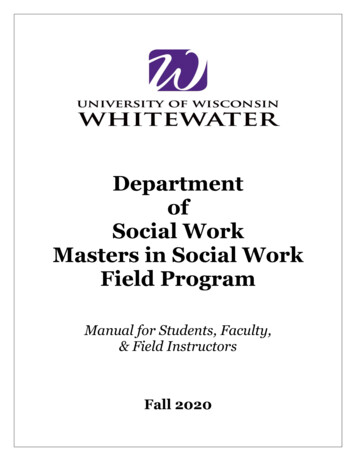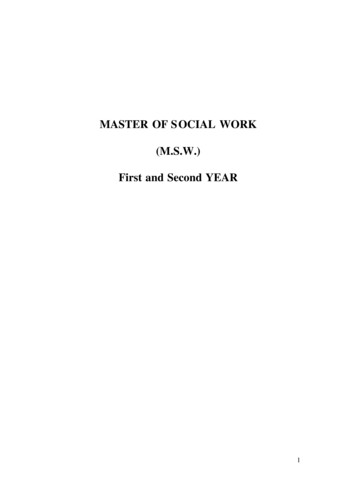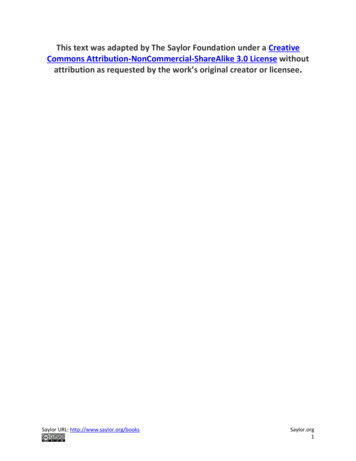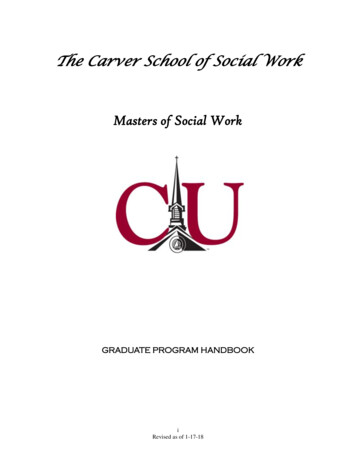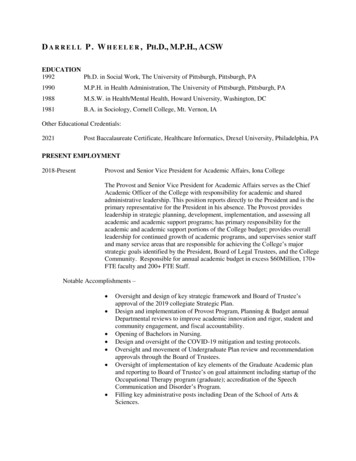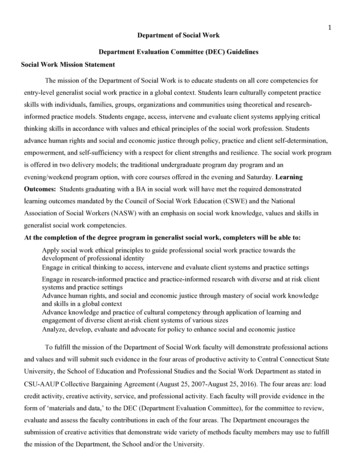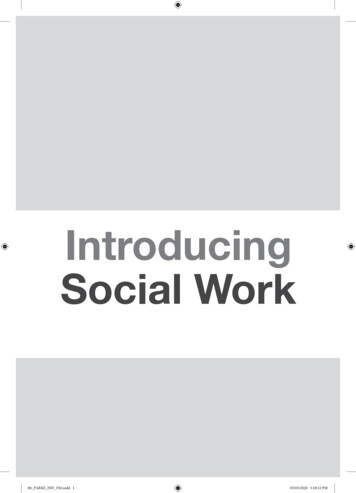
Transcription
IntroducingSocial Work00 PARKE ISW FM.indd 103/03/2020 5:18:12 PM
Sara Miller McCune founded SAGE Publishing in 1965 to supportthe dissemination of usable knowledge and educate a globalcommunity. SAGE publishes more than 1000 journals and over800 new books each year, spanning a wide range of subject areas.Our growing selection of library products includes archives, data,case studies and video. SAGE remains majority owned by ourfounder and after her lifetime will become owned by a charitabletrust that secures the company’s continued independence.Los Angeles London New Delhi Singapore Washington DC Melbourne00 PARKE ISW FM.indd 203/03/2020 5:18:12 PM
IntroducingSocial WorkEdited byJonathan ParkerLearningMatters00 PARKE ISW FM.indd 303/03/2020 5:18:12 PM
Learning MattersA SAGE Publishing Company1 Oliver’s Yard55 City RoadLondon EC1Y 1SPSAGE Publications Inc.2455 Teller RoadThousand Oaks, California 91320SAGE Publications India Pvt LtdB 1/I 1 Mohan Cooperative Industrial AreaMathura RoadNew Delhi 110 044SAGE Publications Asia-Pacific Pte Ltd3 Church Street#10-04 Samsung HubSingapore 049483Editorial arrangement, Chapter 6 and Chapter 16 JonathanParker, 2020. Chapter 1 Jo Finch & Jonathan Parker, 2020.Chapter 2 Steven M. Shardlow, 2020. Chapter 3 BarbraTeater, 2020. Chapter 4 Robert Johns, 2020. Chapter 5 Janet Walker, 2020. Chapter 7 Prospera Tedam, 2020.Chapter 8 Lucy Rai, 2020. Chapter 9 Joanna Rawles,2020. Chapter 10 Juliet Koprowska, 2020. Chapter 11 Allan Norman, 2020. Chapter 12 Timothy B. Kelly, 2020.Chapter 13 Trish Hafford-Letchfield, 2020. Chapter 14 Brian J. Taylor, 2020. Chapter 15 Jo Finch, 2020. Chapter 17 Nancy Kelly, 2020. Chapter 18 Melanie Watts & NickFrost, 2020. Chapter 19 Deborah Hadwin, Helen Guizani &Gurnam Singh, 2020. Chapter 20 Roger Smith & SeanCreaney, 2020. Chapter 21 Toby Brandon, Carole Southall &Steve O’Driscoll, 2020. Chapter 22 Sally Lee, 2020.Chapter 23 Emma Evans & Sally Lee, 2020. Chapter 24 Lucille Allain & Sioban O’Farrell-Pearce, 2020. Chapter 25 Kim Robinson, 2020. Chapter 26 Orlanda Harvey, 2020.Chapter 27 Ann Anka, 2020. Chapter 28 Sue Taplin, 2020.Chapter 29 Keith Popple, 2020.First published in 2020Editor: Kate Keers/Catriona McMullenDevelopment editor: Sarah TurpieSenior project editor: Chris MarkeProject management: Swales & Willis Ltd, Exeter, DevonMarketing manager: Camille RichmondCover design: Wendy ScottTypeset by: C&M Digitals (P) Ltd, Chennai, IndiaPrinted in the UKApart from any fair dealing for the purposes of research orprivate study, or criticism or review, as permitted under theCopyright, Designs and Patents Act, 1988, this publication maybe reproduced, stored or transmitted in any form, or by anymeans, only with the prior permission in writing of the publishers,or in the case of reprographic reproduction, in accordancewith the terms of licences issued by the Copyright LicensingAgency. Enquiries concerning reproduction outside thoseterms should be sent to the publishers.Crown Copyright material is published with the permission ofthe controller of HMSO.Library of Congress Control Number: 2020930947British Library Cataloguing in Publication DataA catalogue record for this book is available from theBritish LibraryISBN 978-1-5264-6335-7ISBN 978-1-5264-6336-4 (pbk)At SAGE we take sustainability seriously. Most of our products are printed in the UK using responsibly sourced papers andboards. When we print overseas we ensure sustainable papers are used as measured by the PREPS grading system. Weundertake an annual audit to monitor our sustainability.00 PARKE ISW FM.indd 403/03/2020 5:18:12 PM
ContentsAcknowledgements About the authors Series editor’s preface IntroductionPart I Social work theory and methods 1 The history and context of contemporary social work(including global social work)Jo Finch and Jonathan Parker2 Social work values and ethicsSteven M. Shardlow3 Theories and methods of social work practiceBarbra Teater4 Social work and the lawRobert Johns5 Human growth and development in social workJanet Walker6 The social work process: assessment, planning, intervention and reviewJonathan Parkerviiiixxiiixv131425374964Part II Social work skills 777 Anti-oppressive practice skillsProspera Tedam8 Writing skills for social workersLucy Rai9 Critical thinking and reflective practiceJoanna Rawles10 Communication and interpersonal skillsJuliet Koprowska11 Courtroom skills for social workersAllan Norman12 Groupwork skillsTimothy B. Kelly and Toby Berman-Rossi13 Leadership and management skills in social workTrish Hafford-Letchfield7900 PARKE ISW FM.indd 59010211312613814903/03/2020 5:18:12 PM
Contents14 Using research in social workBrian J. Taylor15 Looking after yourself as a social workerJo Finch16 Creative skills for social workersJonathan ParkerPart IIISocial work interventions in practice 16017218319317 Social work and safeguarding children195Nancy Kelly18 Social work with children and young people in need208Melanie Watts and Nick Frost19 Working with unaccompanied refugee minors218Deborah Hadwin, Helen Guizani and Gurnam Singh20 Social work and youth justice231Sean Creaney and Roger Smith21 Social work and mental health (children, young people and adults)243Toby Brandon, Carole Southall and Steve O’Driscoll22 Social work and disability (children, young people and adults)254Sally Lee23 Social work and learning disability/difficulties (children, youngpeople and adults)265Emma Evans and Sally Lee24 Social work, fostering and adoption (working with children and adults) 276Lucille Allain and Sioban O’Farrell-Pearce25 Social work with refugees and asylum seekers287Kim Robinson26 Social work and substance use297Orlanda Harvey27 Social work with older people311Ann Anka28 Social work at the end of life: death, dying, bereavement and loss321Sue Taplin29 Working with communities331Keith PoppleAppendix 1: Professional Capabilities Framework Appendix 2: Subject benchmark for social work References Index 342344351389vi00 PARKE ISW FM.indd 603/03/2020 5:18:12 PM
15Looking after yourself asa social workerJo FinchChapter objectivesThe aims of this chapter are: to examine how social workers can effectively look after their health and wellbeing,given the demands and challenges of practice;to explore what stress and burnout are and the damaging and adverse impact theycan have on us, our practice, and service users;to highlight the importance of assertiveness in prioritising our own health andwellbeing and developing a work-life balance.IntroductionSocial work is a very stressful occupation, not least because of the daily exposure tohuman suffering and distress, working in organisations that are subject to intense15 PARKER ISW CH 15.indd 17203/03/2020 5:55:32 PM
Looking after yourself as a social workerpolitical surveillance and inspection regimes, and the constant state of change. Socialwork is also a much maligned and misunderstood profession, often seen as failing interms of either removing children from their parents inappropriately, as in Clevelandand the Orkney Isles, or else failing to spot obvious signs of abuse and neglect, resultingin children’s deaths at the hands of their parents or carers (see Chapter 17). This chapterreviews research on what can exacerbate stress for social workers alongside an examination of compassion fatigue, secondary vicarious trauma and resilience. To begin,however, we explore why we need to look after ourselves as social workers.Why is looking after ourselves important?The question may seem obvious, but it is an important one to ask, as well as somethingwe should remind ourselves of on a daily basis. The first answer is that we cannot do ourjobs effectively, that is, contain and manage the daily stresses and challenges of practice,if our wellbeing is compromised; wellbeing in this sense meaning both physical andmental wellbeing. In other words, we cannot look after others if we cannot look afterourselves first. An obvious analogy is an airline safety demonstration, whereby passengers are advised to put on their own oxygen masks first, before helping others (Grantet al., 2014; Maclean et al., 2018). Looking after ourselves, in its widest sense, will ensureour practice is reflective, thoughtful and decision making accurate and safe. It will ensure ourrelationships with users of social work services are the best they can be, and that wemaintain our capacity to listen to and effectively contain other people’s emotional distress (Cooper, 2018). We should, of course, have due regard for ourselves, whateveroccupation we are in, and it is far from selfish that we focus on our own health andwellbeing. It is important to acknowledge at the outset that there is not currently theevidence to suggest that social work is more stressful than any other caring profession(Lloyd et al., 2002) but all caring professions will inevitably contain stressful elements, interms of the close proximity to other people’s emotional and physical suffering and distress (Cooper and Lousada, 2005). Indeed, the social worker’s role in any specialityshould be the promotion of the wellbeing of others, and as such we must also promoteour own wellbeing and that of our colleagues. Stevenson (2014), writing in the contextof promoting wellbeing in early years settings, argues that practitioners much recognisehow essential their own wellbeing is, if they are to be able to form bonds with children(or young people and adults) that are personal as well as professional. Clearly, serviceusers will be impacted by high staff sickness levels, as well as staff whose conduct isimpacted adversely by suffering from stress. The chapter now goes on to explore howsignificant an issue workplace stress is, both in general terms and within social workin the UK.The extent of the problemThe CIPD (2018), in their annual report of health and wellbeing at work, noted thatin the public sector, mental ill health, followed by stress, is the main reason for longterm sickness absence, with mental ill health the reason cited for the most short-term17315 PARKER ISW CH 15.indd 17303/03/2020 5:55:32 PM
Looking after yourself as a social workersickness absenteeism. The same report also noted an increase in stress related absencesacross a number of professions. Similarly, the Health and Safety Executive (HSE), ontheir website, report that 11 million days are lost at work due to stress and, indeed,employers have a legal duty to protect workers from stress. Research commissionedby the British Association of Social Workers (BASW) in 2018 found that workingconditions of social workers overall are poor (compared with other comparative professions) and are ‘adding to high levels of stress, presentism, job dissatisfaction andintentions to leave both the current job and the social work profession as a whole’(Ravallier and Boichat, 2018, p5). Nonetheless, it is not all doom and gloom, as theresearch on stress and wellbeing more generally focuses on what can help, which willbe discussed later on in this chapter. The discussion for now, however, considers whatstress and burnout are.What are stress and burnout?Stress is a normal part of everyday life; indeed it can be essential for getting up in themorning and for completing everyday tasks, or indeed helps us to finish a last minutetask. Stress describes the physiological process of hormone release when a person experiences a shock or a threat, i.e. the fight or flight response, originally identified by Selye(1955). Selye (1975) later identifies different types of stress: eustress – which is related tosituations when stress enhances functioning; stress which is a reaction; and a stressorwhich is something that causes distress, i.e. when stress continues unresolved and canlead to negative outcomes. Stress, therefore, is more than a physiological reaction;indeed, Maslach et al. (1996) described stress as the emotional as well as physiologicalreactions to stressors. Stress is defined by the HSE (2007) as the ‘adverse reaction a person has to excessive pressure or other types of demand on them’ and the Mental HealthFoundation defines stress as ‘the degree to which you feel overwhelmed or unable tocope as a result of pressures that are unmanageable’ (2018).The term burnout is used to describe the process whereby the worker becomescynical and disengaged. In other words, they may fail to respond professionally toother people’s distress and concerns. Maslach and Leiter (1997) describe this veryevocatively. They argue that burnout has occurred in a worker when they experiencethe dislocation between what people are and what they have to do, it represents an erosionin values, dignity, spirit and will – an erosion of the human soul. It is a malady that spreadsgradually and continuously over time, putting people into a downward spiral from which itis hard to recover (1997, p17)Croucher (2010) argues further that a burned out worker may display detachedbehaviours, is likely to be exhausted, with motivation and drive severely impaired,and may feel an overwhelming sense of helplessness and hopelessness.17415 PARKER ISW CH 15.indd 17403/03/2020 5:55:32 PM
Looking after yourself as a social workerActivity 15.1Stress and impactConsider the following questions before reading the next section.1.2.3.4.Have you worked with someone who you felt was suffering from stress?What behaviours did they exhibit?What was the impact of your colleague’s stress on you and others around them?What was the impact on service users?The impact of stressLong-term exposure to acute stress can have significant implications for the health andwellbeing of individuals and cause a range of short-term physical health issues, such asstomach aches, headaches, and skin complaints, as well as longer term health issues.Indeed, medical research has found that long-term exposure to stress is a contributoryfactor in the development of metabolic syndrome, which is a risk factor for the development of type two diabetes (Chandola et al., 2006), cardiovascular disease (Rosengrenet al., 2004) and stroke, angina, coronary heart disease and hypertension (McEwen,2008). There are also the poor health outcomes associated with maladaptive stressrelated behaviours, i.e. excessive consumption of alcohol, smoking or risk-taking activity.Stress can therefore impact on us in three distinct ways: physiological, emotional andbehavioural. It is worth noting that stress impacts on us in different ways at differenttimes. Some common physiological reactions to stress can include: aches and pains,headaches, muscle tension, exhaustion, sleep disturbances, indigestion, hair loss, disturbance of normal bodily functions, and exacerbation of skin problems, such as eczema orpsoriasis to name but a few (Maclean, 2011).In terms of the emotional impact of chronic stress, feelings we might normally manageeasily become overwhelming. Therefore normal everyday feelings, for example, frustration, being miserable, feeling tense, angry, anxious and under pressure may becomeexacerbated, all of which in turn can impact on our wellbeing both physically and emotionally. It can become a difficult vicious cycle to break out of and, in turn, may lead us toengage in certain behaviours to manage the physical and emotional effects. It is easytherefore to use particular coping strategies, which may work in the short term, but addto the cycle of adverse physiological and emotional impacts. For example, feeling overwhelmed with work tasks may hinder sleep, which makes us tired and exhausted duringthe day, which may make us increase caffeine intake, which may then, in turn, impact onquality of sleep. Similarly, we may respond to stress by over- or under-eating, which mayimpact on stomach complaints, which may then impact on future food choices.Whilst we may not have control over our workloads, or other organisationalpressures, it is important to stress that what we do have a choice about is how weappropriately respond to these pressures. The first step, therefore, in managing stress17515 PARKER ISW CH 15.indd 17503/03/2020 5:55:32 PM
Looking after yourself as a social workeris to ensure our behavioural responses to the issue at hand are positive rather thannegative. So, avoiding the more obvious negative response, such as increasing alcoholconsumption, additional caffeine intake and indeed excessive consumption of chocolate!Activity 15.2StressIdentify the physical and emotional symptoms you experience when under stress andconsider the positive and negative behaviours you engage in as a result.Vicarious trauma and secondary traumatic stressThe term vicarious trauma or secondary traumatic stress refers to the stress caused bybeing in close contact with other people experiencing trauma. Figley (1995) defines it as:the natural, consequent behaviours and emotions resulting from knowledge about a traumatising event experienced by a significant other. It is the stress resulting from helping orwanting to help a traumatised suffering person.(1995, p10)Chrestman (1999) argues that symptoms of secondary traumatic stress (STS) can mirrorthose of people suffering from post-traumatic stress disorder (PTSD) and could includeintrusion, avoidance and arousal behaviours and reactions (Figley, 1995). Intrusion refersto re-experiencing the traumatic event, through dreams, flashbacks or intrusive thoughts(Bride, 2007). Avoidance concerns avoiding any stimuli or situation that may provokememories of the traumatic event. This may include avoidance of particular people or space,or avoidance of thinking about the traumatic event, resulting in some instances in memoryloss of the event (Townsend, 2018). Arousal symptoms can include anxiety, irritability,anger, hypervigilance and difficulties falling or staying asleep (Newell and MacNeil, 2011).Bride (2007), in an American study of 282 social workers, found that almost 98 per cent ofthe people they worked with had experienced trauma and their interventions focused onsupporting service users with trauma. Bride (2007) found that the majority of social workers in the sample experienced low levels of STS symptoms, whereas a small number wereshowing severe symptoms of STS. Bride (2007) concludes from the findings that, independent of any other trauma that social workers may directly experience, the rate of PTSD insocial workers due to indirect exposure to trauma is twice that of the general population.The chapter now goes on to explore compassion fatigue.Compassion fatigueThe term compassion fatigue is often used interchangeably with the terms burnout, vicarious trauma and STS as discussed previously. Indeed, the interchangeability of terms in use17615 PARKER ISW CH 15.indd 17603/03/2020 5:55:32 PM
Looking after yourself as a social workerin the literature is noted by Kapoulitsas and Corcoran (2015). Whilst there may be subtlenuances between the differing terms used, the term compassion fatigue may be a moreappropriate, and perhaps less pathologising and medicalising term to use in social workcontexts. Essentially, therefore, compassion fatigue refers to the response associated withthe exposure to other people’s stress and trauma; it can affect an individual’s emotionalwellbeing, and importantly can be accumulative, i.e. the adverse impacts can build upslowly and over time. Therefore practitioners must be vigilant and self-aware, as will beexplored later on in this chapter.Case study 15.1Juliet has been a social worker for 15 years. She has worked in child safeguarding andnow works in the Looked After Children team. You have noticed her cynical approach tothe work, to change in policies and procedures and an increasing tendency to makenegative comments about the children and young people she is working with. In thecontext of your reading so far, consider what might be happening and why.What factors contribute to stress and burnout in social work?There can be a range of external factors that contribute to social workers’ stress andburnout as well as a person’s individual capacities, or resilience, to manage the demandsof social work. It is important to consider both environmental and individual issues. Asdiscussed earlier, being in close proximity to other people’s trauma or stress may be acontributory factor to social workers experiencing stress, and indeed secondary trauma.Research summaryA study by Gibson et al. (1989), focusing on occupational stress in a sample of 176 NorthernIreland social workers (which also included managers), found that whilst social work stafffelt positive about their roles and social work in general, many reported that they felt asignificant amount of work-based stress. Stressors included: too little time to undertakework, with associated feelings of not being able to meet their own expectations, pressures of external deadlines, a lack of agency in influencing decisions particularly aroundresourcing, and lacking a sense of personal accomplishment. The study utilised two standardised schedules, the General Health Questionnaire (Goldberg, 1978) and MaslachBurnout Inventory (Maslach and Jackson, 1981). The study found that one third of socialworkers reported psychiatric morbidity, which includes somatic symptoms, anxiety andinsomnia, social dysfunction and severe depression. The study found this was higher thanteachers and nurses (who were also included in the study), and the general population ofNorthern Ireland. In terms of the burnout inventory, less than the norm were experiencingburnout. It was disappointing to note that, in this study, supervision was reported as notbeing effective in ameliorating workplace stress. Given the study took place in 1989, the impactof the Northern Ireland Troubles might have also played a potential part in the findings.17715 PARKER ISW CH 15.indd 17703/03/2020 5:55:32 PM
Looking after yourself as a social workerMore general research on workplace stress found that stress increases when workershave high demands coupled with low control in their working lives (Langer, 1983). Asystematic review of stress by Coyle et al. (2005) amongst mental health social workersfound that contributory factors to workers feeling stressed included role conflict, roleambiguity and fulfilling statutory responsibilities. Stress increased when workers felt alack of achievement, high workload and not feeling valued as an employee. The HSEmanagement standards identified six areas that can impact on employees experiencingstress (Health and Safety Executive, date unknown, [a]).These include: Demands. This refers to workload, work patterns and the general environment.Control. The extent to which employees feel they have control (or agency) overtheir work.Support. This includes encouragement, sponsorship and resources provided by theorganisation, as well as from the line manager and colleagues.Relationships. This includes promoting positive relationships within organisations andworking to avoid conflict, as well as managing behaviour from employees that might beconsidered unacceptable.Role. This concerns the extent to which people understand their roles in an organisationand how the organisation ensures employees do not have conflicting roles.Change. This concerns the way that organisational change is managed and communicated within the organisation.As can be seen, public sector organisations, by their very nature, will inevitably be inconstant flux and change, not least due to austerity, and, because of austerity (not leastthe closing of support services) demands on services have inevitably risen and so workloads will be demanding. Further, the role of the social worker has always been achallenging one, not least the perennial role conflict between care and control.What factors mitigate against stress and burnout in social work?As stated at the outset of this chapter, this is not intended to put anyone off becoming asocial worker. It is a stressful job, but research from across professions and disciplinesevidences a range of organisational and individual practices that help support practitioners to effectively manage the day-to-day stresses and challenges of the job. There are twocompeting theories or approaches about managing and dealing with stress (Lazarus andFolkman, 1984). The first one is known as vigilant coping, in other words active copingor finding solutions to address or remove the initial cause of the stress, and emotionfocused coping. Emotion focused coping involves approaches which try to find ways ofmore successfully or positively managing emotional distress (Carver et al., 1989). Interms of the first approach, one strategy concerns support in the workplace (as identifiedin the HSE six management standards discussed earlier). The Health and SafetyExecutive (date unknown [b]) has produced a useful guide in the appendix of a report(pp62–64) about positive management responses to the six areas that can cause stress inemployees. It also details negative management responses that can exacerbate stress. Thisis useful in itself, i.e. perhaps one can assess the responses of those in authority aroundthem (including practice educators) as well as use it as a reflective guide to considerone’s own response to service users and colleagues.17815 PARKER ISW CH 15.indd 17803/03/2020 5:55:32 PM
Looking after yourself as a social workerActivity 15.3 (with one worked example)Having knowledge of what can potentially cause stress in workplaces is useful and thefollowing asks you to reflect on these areas. Consider the worked example and add yourown thoughts to the other fields.Table 15.1Stress in the workplacePotential work place stressorCurrently on my social workprogramme, placement, or asan NQSW or SWer on a scaleof 1–101 negative 10 very positiveWhat can I do to managethis?Positive strategies andcoping skills?Demands – this refers toworkload, work patterns and thegeneral environment.It is very busy, as I ammanaging my placement andmy university work. Currentlyat number 2. I feel quiteoverwhelmed at times.I am organised and I haveprioritised completing mymid-way portfolio. I havea week off and will focuson my course work. Iknow this is time limited.Control – the extent to whichemployees feel they havecontrol (or agency) over theirwork.Support – this includesencouragement, sponsorshipand resources provided bythe organisation, as well asfrom the line manager andcolleagues.Relationships – this includespromoting positive relationshipswithin organisations andworking to avoid conflict, as wellas managing behaviour fromemployees that might beconsidered unacceptable.Role – this concerns the extentto which people understandtheir roles in an organisationand how the organisationensures employees do not haveconflicting roles.Change – this concerns theway that organisational changeis managed and communicatedwithin the organisation.17915 PARKER ISW CH 15.indd 17903/03/2020 5:55:32 PM
Looking after yourself as a social workerCollins (2008) identifies a number of what he termed ‘positive focused coping strategies’ (2008, p1177) which can be usefully employed. These include planning, suppressionof competing activities, restraint and seeking out social support. Colleagues may also bea primary source of support for social workers (Gibson, 1998; Smith and Nursten, 1998;Thompson et al., 1996; Um and Harrison, 1998). Linked to support within the workplace is the protective impact of supervision (Lloyd et al., 2002; Collins, 2015). Lloydet al. (2002) noted further that high workload was manageable if support levels werehigh. Indeed, research by Wilkins et al. (2018) argued that there was evidence tosupport the claim that good supervision can help individual social workers to improvetheir self-efficacy, confidence, resilience, retention and stress levels. A concern, however,has been raised about the purpose of supervision increasingly concerning managementoversight and surveillance, rather than providing a supportive and educative function(Beddoe, 2010). Morrison (2007) identified that help seeking activities were also usefulin combatting stress.Wagaman et al. (2015) explored the extent to which social work practitioners’ levelsof burnout and STS would be mitigated by practitioners’ skills in developing and practising empathy. The study argued that if practitioners can learn and develop their empathicskills and practise them consistently, then it will protect, to some degree, the practitioner,and will promote ‘compassion satisfaction’ rather than compassion fatigue. Compassionsatisfaction is ‘the positive feelings about people’s abilities to help’ (Stamm, 2010, p8).Resilience is a concept that is often used in social work, both in terms of service userswe may work with and ourselves. You will have heard the word used on your social worktraining course and, indeed, being resilient to the stresses and strains of social work ispositive. As Grant and Kinman (2012) argue, resilience can be defined as the ability tomanage and overcome stressful situations, or indeed negative life events, and ‘find personal meaning in them’ (2012, p605). Grant et al. (2015) therefore advise that techniquesto improve self-awareness, reflective ability and developing emotional literacy weresignificant in helping social works develop resilience. A word of warning, however, in thatthe focus on individual resilience can be criticised because it locates the problem withinthe individual, rather than taking the structural issues into account. The next sectionof the chapter, therefore, focuses on employers’ responsibilities.Promoting wellbeing: employers and employeesThe HSE is a governmental regulatory body which aims to reduce workplace accidents,workplace deaths, and injuries at work. They also include workplace stress as a potentialworkplace hazard. The HSE ensures all employers conform to various legislation andpolicies to ensure worker safety. Employers have a duty to
Introduction. xv. Part Iocial work theory and methods S 1. 1tory and context of contemporary social work The his (including global social work) 3 o Finch and Jonathan ParkerJ. 2ocial work values and ethics S. 14 teven M. ShardlowS. 3ories and methods of social work practice The. 25 arbra TeaterB. 4ocial work and the law S. 37 obert JohnsR
